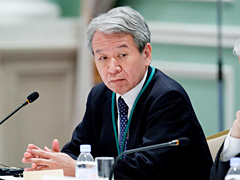Asian nations have the chance to lead the world to a new era of low-carbon prosperity, but only if they embrace revolutionary ideas and technology much as Japan did in the 1970s and avoid the mistakes of other developed countries.
That was a major theme at a recent ministerial level meeting of the East Asia Summit, a grouping of 10 ASEAN member countries and 8 other countries, some of which are the world's largest producers of greenhouse gases.
The Tokyo meeting April 15 explored the issue of how to improve overall Asian economic growth while reducing burgeoning greenhouse gas emissions and establishing prosperous, low-carbon societies.
Asian countries continue to enjoy high economic growth rates and new investment, but will account for around 50% of global greenhouse gas emissions by 2050, Shuzo Nishioka, senior research advisor for the Institute for Global Environmental Strategies said in a side-event JICA helped sponsor at the meeting.

JICA President Akihiko Tanaka makes a speech
These Asian countries need to ‘leapfrog’ from current technology trends and avoid past mistakes by developed countries which used ‘tremendous amounts of energy to underpin growth, and instead follow the pattern of Japan which developed new technologies following the 1970s global oil shocks.
“Asian countries must ‘leapfrog in their development by changing the current challenges caused by climate change into opportunities,” he said.
In the meeting, the new President of the Japan International Cooperation Agency, Akihiko Tanaka summarized the tenor of those discussions in a presentation. He emphasized the importance of encouraging the widespread use of energy efficient technologies, promotion of renewable energy sources, reducing environmental and forest degradation and promoting efficient transportation systems in burgeoning Asian cities.
Tanaka highlighted some JICA’s flagship projects and programs that have contributed to sustainable economic growth in Thailand, Vietnam and Indonesia and pledged that going forward JICA would promote low carbon growth in East Asia by utilizing the outputs from this meeting.




scroll